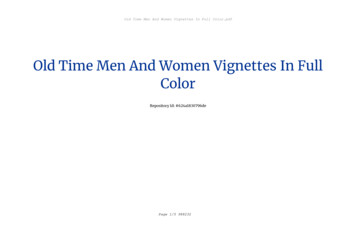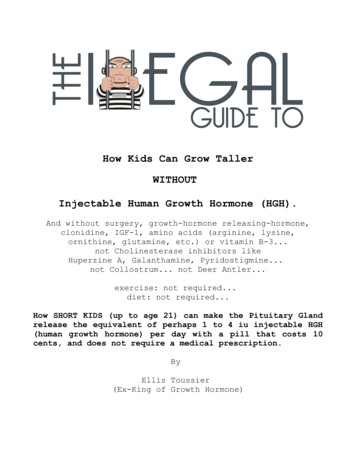
Transcription
“Determination of Recent Growth Hormone Abuse Using a Single Dried BloodSpot”Running head: Dried blood spot in growth hormone abuse detectionGemma Reverter-Branchata, Jaume Boscha, Jessica Valla, Magí Farréb,c, d, EstherPapaseitb,c,d, Simona Pichinie, Jordi Seguraa,f,*a Bioanalysis Research Group, Neurosciences Research Program, IMIM (Hospitaldel Mar Medical Research Institute), Barcelona, eResearchGroup,Neurosciences Research Program, IMIM (Hospital del Mar Medical ResearchInstitute), Barcelona, Spainc Department of Pharmacology, Therapeutics and Toxicology and Department ofPsychiatry, Universitat Autònoma de Barcelona (UAB), Cerdanyola del Vallès(Bellaterra), Spain.d Clinical Pharmacology Unit. Hospital Universitari Germans Trias i Pujol-IGTP,Badalona, Spaine Istituto Superiore di Sanita, Roma, Italyf Department of Experimental and Health Sciences, Pompeu Fabra University,Barcelona, isResearchGroup,Neurosciences Research Program, IMIM (Hospital del Mar Medical ResearchInstitute). C/Dr. Aiguader 88, 08003, Barcelona, Spain. Phone: 34 93 316 04 00.Fax: 34 93 316 04 10. E-mail address: jsegura@imim.es.Keywords: Dried blood spot, growth hormone abuse, doping, serum decision limits,isoforms immunoassay.Abbreviations: DBS, dried blood spot; hGH, human growth hormone; WADA, WorldAnti-Doping Agency; rhGH, recombinant hGH; mAb, monoclonal antibody; oassay; DL, Decision Limit.1andControl;LIA,luminescent
Abstract (limit 250 words)Background:Although being increasingly applied, blood collection for drug testing in sportpresents some logistic issues that complicate full applicability on a large scale. Theuse of dried blood spots (DBS) could benefit compliant blood testing considerablyowing to its simplicity, minimal invasiveness, analyte stability and reduced costs. Theaim of this study was to evaluate the applicability of DBS to the methodologyapproved by the World Anti-Doping Agency (WADA) for detection of doping byrecombinant human growth hormone (rhGH) in serum.Methods:A protocol for a single DBS analysis using the hGH isoforms differentialimmunoassays (Kit 1 and Kit 2) was developed and validated. A clinical study withhealthy volunteers injected for three consecutive days with a low subcutaneous dose(0.027 mg-1kg-1day-1person-1) of rhGH was conducted. Finger prick DBS and pairedtime serum samples from arm venipuncture were compared.Results:The analysis of the DBS-based protocol indicated that with only a single blood spot itwas possible to detect positivity for growth hormone abuse. In spite of the low rhGHdose administered and independently of the kit used, the window of detection forDBS was confirmed in all analyzed samples up to 8 h after rhGH administration andextended up to 12 h in 50% of the cases. Serum positivity was detected in all studiedsamples for 12 h after administration.Conclusions:These results support the usefulness of DBS as a biological matrix for testing recentgrowth hormone abuse.2
1Introduction2Human Growth Hormone (hGH) is a protein hormone synthesized and secreted by3the pituitary gland (1). The use of its recombinant analogue is believed to be4widespread in sports as a performance-enhancing substance and therefore the5recombinant compound has been included in the WADA Prohibited List (2). The6direct method to detect recombinant hGH (rhGH) abuse in sport is based on the7quantification of hGH variants in serum using monoclonal antibodies (mAb) (3;4).8Endogenous hGH is present in several isoforms with different structures (22-kDa,920-kDa, acidic GH, and others) and different aggregation status (monomers, dimers,10oligomers) (1;5). The rhGH, commercially produced for therapeutic use, corresponds11to the 22-kDa isoform and after administration it becomes predominant in the body12(1;3). The doping strategy takes advantage of this fact and the hGH isoforms test13has been developed based on two separate immunoassays applied to blood serum14(3;6). The first assay (named “rec”) contains a capture antibody that preferentially15recognizes the 22-kDa isoform whereas the second assay (named “pit”) has a16capture antibody that binds to a broader number of pituitary isoforms present in the17body (1;4). The detection antibody, common to both assays, recognizes the 22-kDa18isoform bound by the capture antibody (4). Administration of rhGH, by increasing the1922-kDa isoform and producing some suppression of the endogenous hGH forms,20increases the relative ratio between the “rec GH” and “pit GH”, thereby providing21evidence of administration of the prohibited form (1;4). Specifically, WADA guidelines22demand the application of two different tests (kit 1 and kit 2; both involving “rec” and23“pit” assays, with different capture antibodies) to the sample to validate and confirm24positivity (6). The corresponding Decision Limit (DL) for males, established in WADA25technical documents, is recGH/pitGH ratio 1.84 for kit 1 and 1.91 for kit 2 (6;7). Dried3
26blood spots (DBS) analysis has been used for newborn screening to detect27biomarkers of certain diseases for more than 50 years (8). In recent times, this type28of analysis has gained interest in areas such as drug development, toxicology and29clinical diagnosis (9-11). DBS involve the deposition onto a specific filter paper of30drops of blood collected via finger or heel prick (11;12). Compared to traditional31sampling collection, DBS offer benefits including minimal invasiveness, easier32storage and transport, and longer stability, thereby constituting a promising matrix for33anti-doping purposes (9;11;12). Current protocols for venous blood collection of anti-34doping samples require a licensed phlebotomist under the supervision of a doping35control officer and the need to dispatch samples as soon as possible after collection,36ideally arriving at the anti-doping accredited laboratory on the same collection day,37and preferably within 36 h of collection (13). The conditions required by these38protocols limit the times and location of sample collection owing to their substantial39expense and logistical difficulty. The introduction of DBS could improve those40constraints for sample collection for banned substances included in the World Anti-41Doping Agency (WADA) prohibited list (2), which require blood instead of urine for42successful detection. Some studies have been performed to demonstrate suitability43of DBS in sports drug testing, focused either on small drug molecules or peptide44hormones, indicating the growing interest in the field (14-19). In these cases,45protocols have relied on mass spectrometry technologies to quantify banned drugs,46but the appropriateness of DBS use for detection of doping substances using47immunoassays included in WADA guidelines has received very little attention.48Nevertheless, many published papers support the reliability of dried blood measures49for a growing list of proteins by using antibody binding based techniques (20-22).50Venous blood collection logistics may limit the number of anti-doping controls for4
51those substances, like rhGH, that can only be detected in blood. To circumvent these52limitations, we studied the appropriateness of DBS in the investigation of rhGH53abuse using the hGH isoforms test immunoassay.5
54Materials and methods55Chemicals and material56rhGH (Genotonorm ) was provided by Pfizer Laboratories. Sheep serum was57supplied by Sigma-Aldrich. Differential Immunoassays of hGH Isoforms “hGH LIA Kit581” and “hGH LIA Kit 2” were obtained from CMZ-Assay. Anhydrous disodium59hydrogen phosphate (Na 2 HPO 4 ) and monohydrate sodium dihydrogen phosphate60(NaH 2 PO 4 H 2 O) were from Merck. Bovine serum albumin was purchased from61Sigma-Aldrich. Filter paper FTA DMPK-C Cards were obtained from GE Healthcare62UK Ltd. Capillary blood was obtained by finger prick using ACCU-CHEK Safe-T-Pro63Plus lancet from Roche. Serum (with gel separator) and EDTA blood collection tubes64were purchased from BD.65Method validation66A detailed explanation of protocols used for validation of single DBS analysis by hGH67isoforms test is described in the online Supplemental Text 1. Specifically, limit of68detection (LOD), lower limit of quantification (LLOQ), intra and inter-assay precision,69linearity, volume effect, matrix effects, anatomical (venous blood vs. finger prick)70effect and storage/transport stability were determined.71Study design and sample collection72The study was done in accordance to national and international ethical guidelines73(Declaration of Helsinki) and approved by the local Ethics Committee of Clinical74Research (CEIC) from Parc de Salut Mar (Code IMIMFTCL/GH/2) and the Spanish75Medicines Agency (EUDRACT number 2012-003695-38). Selection criteria included6
76the absence of organic or psychiatric disorders at the time of the study and normal77analytical values within the population limits after medical examination. Participants78were informed about the objectives and procedures of the study and signed an79informed consent document. Because WADA technical document reports that either80kit may be used for the initial testing procedure with serum samples (6), a pilot study81was done aiming to study performance of these kits using DBS samples. In an open82controlled83subcutaneously with 2 mg of rhGH once daily at 8:00 h for three consecutive days,84equivalent to a mean dose of 0.027 mg-1kg-1day-1person-1. Concomitantly, two85volunteers not treated but subjected to the same sample collection protocol were86included as control (blank) subjects. Subsequently, an open clinical trial was carried87out with eight male volunteers that were subjected to the same rhGH injection88protocol as the two treated individuals in the pilot study. Demographic characteristics89of all participants (mean SD) were age 23.5 2.1 (years), height 1.78 0.06 (m) and90weight 72.9 8.7 (kg). Treatment was well tolerated and no serious adverse events91related to medication occurred during the trial nor afterwards. Sample collection for92all participants was done at 0, 8, 24, 32, 48, 52, 56, 60 and 72 h after first dosage.93Blood from arm venipuncture was collected both in gel separator tubes and in EDTA94tubes containing the anti-clotting agent. The gel separator tubes were centrifuged95and the obtained serum was divided into aliquots and stored at -20ºC. For capillary96DBS collection, blood was obtained by pricking the fingertip and spotting blood drops97directly onto circles printed in the paper cards. DBS spots were left to dry a minimum98of 4 h and stored refrigerated until swereinjected
99DBS extraction100For DBS sample extraction, whole blood spots were punched out manually and the101filter paper circles transferred to clean tubes. One mL of extraction buffer (25 mmol/L102sodium phosphate, 0.4% bovine serum albumin, pH 5) was added to the tube,103mixed for 30 seconds by vortexing and incubated for 4 h at room temperature while104gently shaking. After incubation, filter circles were removed and the buffer containing105the extract was transferred into a new tube, lyophilized overnight and stored at -20ºC106until further analysis. For immunoassay performance, each freeze-dried extract was107reconstituted with a volume of 150 µL of sheep serum, enough to fully solubilize108lyophilized the content and to add 50 µL to each assay tube (recGH and pitGH).109Immunoassay (GH analysis)110Differential immunoassays of hGH isoforms were performed according to the111manufacturer’s instructions and assay measurement was done with the AutoLumat112LB 953 Multi-Tube Luminometer with LBIS software version v3.3 (Berthold113Technologies)114Data processing and statistical analysis115WADA guidelines for hGH immunoassays in serum (6) were applied to evaluate the116results observed in serum. Accordingly, for the purposes of calculating the117recGH/pitGH ratio, recGH and pitGH concentrations below respective assay LLOQ118were replaced by the LLOQ value established in the Laboratory. These LLOQ values119for recGH and pitGH concentrations in serum for kit 1 were 0.030 and 0.038 and for120kit 2 were 0.029 and 0.043 µg/L respectively. For clinical trial DBS, recGH and pitGH8
121concentrations below the functional sensitivity established for the DBS method122validation similarly were replaced by the corresponding LLOQ (Table 1).123For statistical analysis of the comparison data, data normality was assessed by the124Kolmogorov-Smirnoff test and Pearson correlation coefficients (r) were calculated125using SPSS 18 software (IBM). The level of agreement between serum and DBS126methods was assessed using Bland-Altman plot values (bias and limits of agreement127as SD 1.96), means and SD were calculated using Microsoft Excel 2010 (Microsoft128Corporation) and SPSS 18 software (IBM). Deming regression parameters were129calculated using the R statistical software environment (http://www.r-project.org) and130the MethComp package.9
131Results132Method validation133The performance of hGH isoforms test using a single DBS was studied (see Table1341). As the real amount of serum analyzed by each single spot was lower than the135standard assay (50 µL), the real LOD and LLOQ values for DBS were higher than136those for serum provided by manufacturer as well as those in-house determined for137the standard serum method. Intra-assay and inter-assay precision ranges remained138all within a CV 20%. Linearity recovery range for each recGH and pitGH assays was139in all cases 15%. Reproducibility of the recGH/pitGH ratio was confirmed to be140maintained also 10.1% of the undiluted original value down to a 1:27 dilution of a141real positive sample. A linear relationship between dilution factor and sample142concentration with correlation coefficients 0.995 was observed for all the four kits143assayed. Particular partial effects of analyzed volume and aspects associated to144DBS approach (whole blood components, filter paper support) are summarized in the145online Supplemental Text 1. As presented there, no differences for recGH/pitGH146ratio were observed between DBS from finger or DBS from arm vein blood. The147stability of the recGH/pitGH ratio was not affected by storage of DBS at room148temperature including intercontinental air flights to simulate real anti-doping samples149transportation.10
150Clinical studies151Pilot study152Initial data were obtained from a pilot study involving two participants treated with153rhGH (administered once daily for three days) and two control non-treated154individuals. Extracts from a single DBS obtained by finger prick and paired-time155serum samples obtained by venipuncture were analyzed with both kit 1 and kit 2 for156each subject/time (Fig. 1A and 1B). The decision limit (DL) for males established by157WADA for both kits in serum is indicated in the figure by a reference line in the158corresponding axis (kit 1 1.84 and kit 2 1.91) (6;7). In the two non-treated controls,159no false positive was observed for the ratio recGH/pitGH. Conversely, DBS160recGH/pitGH ratios of volunteers treated with rhGH largely peaked over the WADA161threshold at least for 8 h after each hormone administration. At 12 h after the last day162of administration (time point 60 h), DBS ratios for recGH/pitGH were still clearly163higher than the three time points corresponding to 24 h post-administration (time164points 24, 48 and 72 h) as well as all time points of the two control individuals.165However they were slightly lower than DLs established by WADA for serum to166provide a positive result. In serum samples analyzed in the two treated participants,167positivity was shown up to 12 h after last recombinant rhGH injection (time point 60168h) but was negative thereafter. The direct comparison of recGH/pitGH ratios between169kits in the two treated individuals indicated that although some quantitative but not170significant (P 0.05) differences existed between kits (kit 1 usually higher than kit 2),171the kits yielded similar patterns of results. Interestingly, correlation coefficient among172kits (Fig. 1C and 1D) was marginally higher for DBS (r 0.97) than for serum (r 0.94)11
173and the correlation between DBS and serum indicated linearity for kit 1 (r 0.93) and174kit 2 (r 0.93) (Fig. 1E and 1F).175Clinical trial with eight treated individuals176Following the results of the pilot study, the eight individuals included in the clinical177trial were submitted to the same protocol as those in the pilot study, namely, a dose178of rhGH once daily for three days. Biological samples (DBS and serum) for half of179them were analyzed with kit 1 and the other half with kit 2 (Fig. 2). The analysis of180single DBS revealed that, applying WADA criteria, positivity was confirmed in 100%181of the cases after 4 h (time point 52 h) and 8 h (time points 8, 32 and 56 h) of182treatment and in 75% of the samples after 12 h of treatment (time point 60 h). For183serum, all samples (50 µL serum analyzed with the standard protocol) tested positive184after 4 h (time point 52 h), 8 h (time points 8, 32 and 56 h) and 12 h (time point 60 h)185of hormone administration, in agreement with previous reported data (3). Only a186portion (29%) of serum samples analyzed after 24 h of rhGH injection (time points18724, 48 and 72 h) showed ratios over DL independently of the kit used. However,188most such cases (71.4%) could not be confirmed for positivity since they did not189meet WADA criteria for acceptance in serum (recGH 0.150 µg/L) (6).190General comparison of DBS vs. serum in all treated individuals191Ratios recGH/pitGH obtained throughout the study for serum and DBS samples from192all volunteers treated with rhGH have been graphically represented (Fig. 3). A193detailed list of the concentrations and ratios obtained with DBS and serum samples12
194has been included in the supplemental material (Suppl. Table S2). Although195quantitative differences existed between serum and DBS matrices, the curve shapes196for both showed a similar profile. Clearly, the ratios at collection times 8, 32 and 56 h197were positive either with serum (respectively, mean SD for kit 1: 6.64 2.20;1986.36 0.83; 7.36 1.76 and for kit 2: 4.22 0.60; 4.90 0.97; 5.87 1.31) or with DBS199(respectively, for kit 1: 3.78 1.07; 3.96 0.86; 3.89 0.59 and for kit 2: 3.45 0.83;2003.31 0.35; 3.65 0.36). In addition, sensitivity was assessed for both DBS and serum201at 12 h after third administration (time point 60 h). As previously described (1;3),202serum ratios felt above the DL (kit 1: 4.71 1.76 and kit 2: 4.40 1.33). In the case of203DBS, mean values (kit 1: 1.96 0.87 and kit 2: 2.15 1.00) were close to but above204the same thresholds established by WADA for serum. As compared with 100% for205serum, 50% of DBS samples were above DL at this time. The comparative study206between serum and DBS recGH/pitGH ratios by Deming regression analysis207indicated a correlation between the serum and the DBS methods with both kits (Fig.2084A and 4B). Specifically, for kit 1 the slope was 0.51 and the intercept 0.05, with a209Pearson correlation coefficient (r) of 0.81 (95% limits of agreement 0.69 to 0.88) and210S x y 1.02. For kit 2, the slope was 0.72, the intercept -0.31, the Pearson correlation211coefficient (r) 0.87 (95% limits of agreement 0.78 to 0.92) and the S x y 0.69. The212corresponding Bland-Altman plot analysis with the difference between serum and213DBS recGH/pitGH ratios relative to serum recGH/pitGH ratio with both kits is shown214in Fig. 4C and 4D. For kit 1, the bias was 0.40 (95% limits of agreement -0.46 to2151.27) whereas for kit 2 it was 0.45 (95% limits of agreement -0.11 to 1.01). As216expected, biases were the result of the previously observed higher recGH/pitGH217ratios values for serum than for DBS.13
218Discussion219The aim of this study was to explore the application possibilities of DBS matrix for220blood anti-doping sampling purposes using the current analytical method to detect221rhGH abuse approved by the World Anti-Doping Agency. In fact, the suggestion of222alternative matrices for rhGH analysis is not new, as urine also has been proposed223recently (23). We have tested a DBS-based methodology that can be successfully224applied to the current protocols to detect rhGH misuse with a window of detection up225to 8-12 h analyzing a single blood spot as DBS.226Classic workflow for DBS analysis involves the partial punching of a 3-6 mm227diameter disc followed by extraction protocol and posterior analysis (24). This228approach raises DBS critical issues like hematocrit effect and heterogeneous229distribution of blood on the card. In the present study, these problems have been230avoided by extracting the whole spot as has been previously proposed (24). In231addition, the measurement of the isoforms ratio has eliminated another concern, the232influence of spotted blood volume, because isoform proportions are expected to be233maintained independently of the volume deposited in the spot.234The validation of a method for the use of one single DBS has been developed.235Owing to a reduced sample volume of sample, functional sensitivity values of DBS236were found to be lower (higher concentrations) than those determined in serum237samples by the standard method. Nevertheless, intraday precision and interday238precision CV 20% indicate suitability of the method for bioanalytical purposes.239Furthermore, linearity appeared adequate for the purposes of anti-doping controls.14
240No influence of blood anatomical origin, either capillary from finger of venous from241arm, was observed on the final ratio. Finally, the long term stability of the target242analytes in DBS was an additional advantage for the use of such collection and243transport matrix.244WADA guidelines establish that when a sample is received for initial screening of245rhGH, either one of the two kits can be used. If results for this first test are above DL,246then the analysis has to be repeated with the kit already used and results confirmed247with the complementary kit (6). Slight differences between kits regarding248recGH/pitGH serum ratio values are already known at moderate dose of rhGH249treatment that becomes somewhat accentuated at higher dosages (3;25). In the250present study, where a low dose (mean 0.027 mg/kg) was administered, a251comparison of kit performance was done in the pilot study revealing some252differences between ratios obtained with the two kits, which were not found253statistically significant in any case. Thus, in the context of this study, kits were254practically exchangeable in terms of detection capability, not only when serum was255used but also for DBS.256In the original publication describing detection of rhGH abuse using the hGH isoform257tests (3), the window of opportunity in serum was related to the administered258dosage. In men, after a high rhGH dose (0.083 mg/kg), ratios were reported above259the DL for 32-34 h. Concomitantly, after a “moderate dose” (0.033 mg/kg), the260detection limit decreased to 18 h. In an excretion study comparing rhGH from261different origins after a single injection of 0.1 IU/kg (corresponding to 0.033-0.040262mg/kg depending rhGH source) a detection window between 12-18 h in serum was263demonstrated (25). In the present study, by single DBS use, this positivity has been15
264fully confirmed up to 8 h (up to 12 h in half of the samples) after rhGH administration265of a lower dose (mean 0.027 mg/kg) independently of the kit used for the assay. The2668 h limit of DBS use is a function of the low volume of initial sample applied to the267assay, which obviously decreases the sensitivity of the technique.268Mass spectrometry based analysis of peptide drugs is emerging as a valuable option269to immunoassays in the anti-doping field (11) and some studies have evaluated the270suitability of DBS use combined with mass spectrometry analysis (16;17). A method271has been already published to detect and differentiate 22-kDa and 20-kDa GH272isoforms in finger prick liquid samples by LC-MS/MS after heavy exercise (26).273Results provided here indicate that extension of this approach to DBS samples274appears to be feasible. Interestingly, a DBS methodology for the determination by275LC-MS/MS of IGF-1, an alternative protein biomarker for rhGH administration (6),276has been recently shown, and is supported by the United States Anti-Doping Agency277(17;27).278In this report the usefulness of DBS for sample collection to detect rhGH abuse has279been confirmed. This has been achieved by using the present WADA approved280methodology with ratios calculated from values resulting from two different281immunoassays. Indeed, the current DLs established for serum allow the detection of282positivity in DBS. Overall, results obtained here support the potential use of DBS as283a biological matrix for particular tests developed by anti-doping laboratories for284routine testing in blood.16
AcknowledgementsWe thank Dr. Gutierrez-Gallego, Dr. Ferro-Gallego, Dr. Pérez-Mañá, Mrs. Menoyo,Mrs. Martin, Mrs. Gibert, Mrs. Pérez and Mr. Langhor for their assistance.17
Reference List1. Baumann GP. Growth hormone doping in sports: a critical review of use and detectionstrategies. Endocr Rev 2012;33:155-86.2. The 2016 Prohibited List International Standard. World Anti-Doping Agency (WADA).https://wada-main-prod s3 amazonaws f 2016.3. Bidlingmaier M, Suhr J, Ernst A, Wu Z, Keller A, Strasburger CJ, Bergmann A. High-sensitivitychemiluminescence immunoassays for detection of growth hormone doping in sports. ClinChem 2009;55:445-53.4. Bosch J, Ueki M, Such-Sanmartin G, Segura J, Gutierrez-Gallego R. Tracking growth hormoneabuse in sport: a comparison of distinct isoform-based assays. Anal Chim Acta 2012;733:5663.5. Baumann GP. Growth hormone isoforms. Growth Horm IGF Res 2009;19:333-40.6. WADA Technical Document - TD2015GH Human Growth Hormone (hGH) Isoform DifferentialImmunoassays for Doping Control Analyses. World Anti-Doping Agency (WADA).https://www wada-ama org/en/resources/science-medicine/td2015-gh 2015.7. Hanley JA, Saarela O, Stephens DA, Thalabard JC. hGH isoform differential immunoassaysapplied to blood samples from athletes: decision limits for anti-doping testing. Growth HormIGF Res 2014;24:205-15.8. Guthrie R, Susi A. A simple phenylalanine method for detecting phenylketonuria in largepopulations of newborn infants. Pediatrics 1963;32:338-43.9. Henion J, Oliveira RV, Chace DH. Microsample analyses via DBS: challenges andopportunities. Bioanalysis 2013;5:2547-65.10. Sadones N, Capiau S, De Kesel PM, Lambert WE, Stove CP. Spot them in the spot: analysis ofabused substances using dried blood spots. Bioanalysis 2014;6:2211-27.11. Martin NJ, Cooper HJ. Challenges and opportunities in mass spectrometric analysis ofproteins from dried blood spots. Expert Rev Proteomics 2014;11:685-95.12. Wagner M, Tonoli D, Varesio E, Hopfgartner G. The use of mass spectrometry to analyzedried blood spots. Mass Spectrom Rev 2014.13. Blood sample collection guidelines v3.0. World Anti-Doping Agency (WADA). https://wadamain-prod s3 amazonaws com/wada-blood sample collection guidelines-v3 0-en pdf pdf2016.14. Peng SH, Segura J, Farre M, de lT, X. Oral testosterone administration detected bytestosterone glucuronidation measured in blood spots dried on filter paper. Clin Chem2000;46:515-22.18
15. Thomas A, Geyer H, Schanzer W, Crone C, Kellmann M, Moehring T, Thevis M. Sensitivedetermination of prohibited drugs in dried blood spots (DBS) for doping controls by meansof a benchtop quadrupole/Orbitrap mass spectrometer. Anal Bioanal Chem 2012;403:127989.16. Moller I, Thomas A, Geyer H, Schanzer W, Thevis M. Development and validation of a massspectrometric detection method of peginesatide in dried blood spots for sports drug testing.Anal Bioanal Chem 2012;403:2715-24.17. Cox HD, Rampton J, Eichner D. Quantification of insulin-like growth factor-1 in dried bloodspots for detection of growth hormone abuse in sport. Anal Bioanal Chem 2013;405:194958.18. Tretzel L, Thomas A, Geyer H, Gmeiner G, Forsdahl G, Pop V et al. Use of dried blood spots indoping control analysis of anabolic steroid esters. J Pharm Biomed Anal 2014;96:21-30.19. Thevis M, Kuuranne T, Geyer H, Schanzer W. Annual banned-substance review: analyticalapproaches in human sports drug testing. Drug Test Anal 2015;7:1-20.20. Schutt BS, Weber K, Elmlinger MW, Ranke MB. Measuring IGF-I, IGFBP-2 and IGFBP-3 fromdried blood spots on filter paper is not only practical but also reliable. Growth Horm IGF Res2003;13:75-80.21. Oglesbee D, Kroll C, Gakh O, Deutsch EC, Lynch DR, Gavrilova R et al. High-throughputimmunoassay for the biochemical diagnosis of Friedreich ataxia in dried blood spots andwhole blood. Clin Chem 2013;59:1461-9.22. Andersen NJ, Mondal TK, Preissler MT, Freed BM, Stockinger S, Bell E et al. Detection ofimmunoglobulin isotypes from dried blood spots. J Immunol Methods 2014;404:24-32.23. Bosch J, Luchini A, Pichini S, Tamburro D, Fredolini C, Liotta L et al. Analysis of urinary humangrowth hormone (hGH) using hydrogel nanoparticles and isoform differential immunoassaysafter short recombinant hGH treatment: preliminary results. J Pharm Biomed Anal2013;85:194-7.24. Fan L, Lee JA. Managing the effect of hematocrit on DBS analysis in a regulated environment.Bioanalysis 2012;4:345-7.25. Jing J, Yang S, Zhou X, He C, Zhang L, Xu Y et al. Detection of doping with rhGH: excretionstudy with WADA-approved kits. Drug Test Anal 2011;3:784-90.26. Such-Sanmartin G, Bache N, Bosch J, Gutierrez-Gallego R, Segura J, Jensen ON. Detection anddifferentiation of 22kDa and 20kDa Growth Hormone proteoforms
3 1 Introduction 2 Human Growth Hormone (hGH) is a protein hormone synthesized and secreted by 3 the pituitary gland(1). The use of its recombinant analogue is believed to be 4 widespread in sports as a performanceenhancing substance and therefore- the recombinant compound has beenincluded in the WADA Prohibited List 5 2). The (6 direct method to detect recombinant hGH (rhGH) abuse in sport is .










